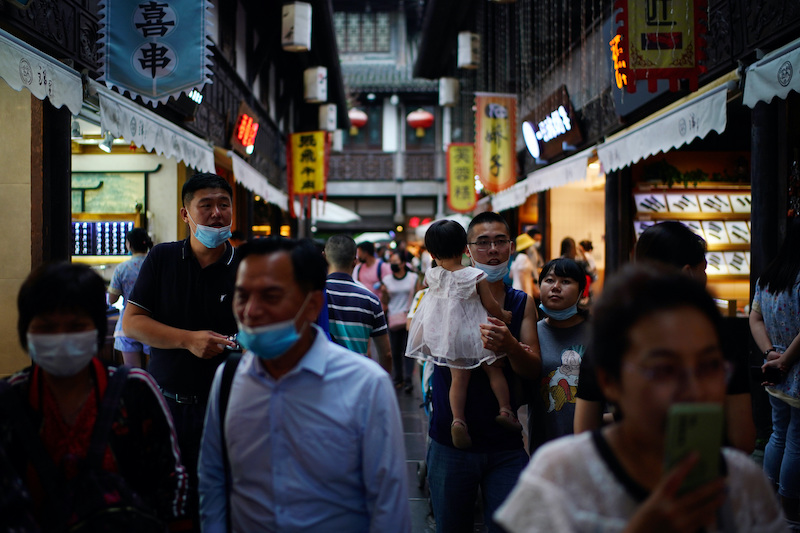An earthquake of 6.8 magnitude that rocked Sichuan in China’s southwest on Monday killed at least 21 people and shook the provincial capital of Chengdu, where over 21 million people are locked down because of a Covid outbreak.
Roads and homes near the epicentre were damaged by landslides, while communications were down in at least one area, state television reported.
No damage to dams and hydropower stations within 50 km (31 miles) of the epicentre was reported, although damage to the provincial grid had affected power to about 40,000 end-users.
The epicentre was at the town of Luding, the China Earthquake Networks Centre said, in the mountains about 226 km southwest of Chengdu.
Earthquakes are common in Sichuan, especially in its mountains in the west, a tectonically active area along the eastern boundary of the Qinghai-Tibetan plateau. This one was the strongest to hit the region since 2017.
ALSO SEE: China’s PBOC Cuts Banks’ FX Ratio to Limit Yuan Weakness
Residents in Sichuan have had a tough few weeks, given the record-breaking heatwave that the region had to endure until recently.
Laura Luo, who lives in Chengdu, a city of about 21 million people, was on her way to her apartment block when she saw people rushing out of their high-rise homes in panic after getting earthquake warnings on their phones.
“There were many people who were so terrified they started crying,” the international PR consultant said. “All the dogs started barking. It was really quite scary,” she said, referring to when the quake began.
In Luding, the quake was so strong it was hard for some people to remain standing, while cracks appeared on some houses, the China News Service reported.
Video clips on social media showed lights swinging while people rushed out of buildings into the streets. Four of the seven people killed were in Luding.
A total of 39,000 people live within 20km of the epicentre and 1.55 million within 100 km, according to state television.
The quake was Sichuan’s biggest since August 2017, when a. 7.0 magnitude temblor hit the Aba prefecture.
The most powerful Sichuan earthquake on record was in May 2008, when a magnitude 8.0 quake centred in Wenchuan killed almost 70,000 people and caused extensive damage.
Monday’s quake was also felt in the provinces of Yunnan, Shaanxi and Guizhou hundreds of kilometres away, according to state media.
Chengdu resident Samantha Yang, 23, was in bed about to take a nap when the quake struck.
“The building kept shaking, each time more severely than before,” Yang said. “Truly, this was the scariest one since the 2008 Wenchuan earthquake.”
Chengdu Lockdown Extended, Flights Cancelled
Chengdu put its 21.2 million people under lockdown last week. And on Monday officials extended the lockdown for most people to Wednesday to enable authorities to complete another round of mass testing that began on Monday.
As of Monday morning, 88% of flights at Chengdu’s Shuangliu Airport had been cancelled while the city’s Tianfu Airport saw 95% of its flights cancelled, up from 62% and 79% respectively, on Thursday, the first day of the lockdown.
Flights in many other cities remain suspended.
The flight cancellation rate at Lhasa’s Gongga Airport in Tibet was at 97% and Sanya’s Phoenix Airport in Hainan province in the south was at 90%, while Xining’s Caojiapu Airport in northwestern Qinghai province stood at 96% and Shenzhen’s Baoan Airport was at 82%.
Shenzhen ‘Stabilising’
Shenzhen city, meanwhile, eased its Covid lockdown on Monday as infections in its latest outbreak showed signs of stabilising.
An outbreak since late August prompted the technology hub to order most of its 17.7 million residents to remain largely at home over the weekend and to take two rounds of tests. Bus and subway services in districts conducting tests were suspended.
By Monday, some restrictions on dining and visits to some parks were eased and many subway stations resumed operations, in an effort to minimise disruption while adhering to the government’s zero-Covid policy that aims at containing each and every outbreak.
Shenzhen, which is near Hong Kong, found fewer infections among those who hadn’t been quarantined in recent days. The latest data showed 71 new local cases for Sunday, down from 89 a day earlier, while the cumulative figure of about 500 cases since late August is fewer than the total in the city’s last major outbreak in mid-March.
But the southeastern city remains on high alert for subvariants of the Omicron variant of the novel coronavirus, which emerged in the central Chinese city of Wuhan in late 2019.
Entertainment venues are shut and large events suspended in most areas, and most people are banned from residential compounds unless they’re on a list of people allowed in. Targeted lockdowns are imposed in areas deemed at high risk.
- Reuters with additional editing by Jim Pollard
ALSO SEE:
Fresh snap lockdowns put China’s economic recovery in peril
Concern on Impact of Covid Curbs in China’s Big Business Hubs
China Shuts World’s Biggest Electronics Market Due to Covid
























